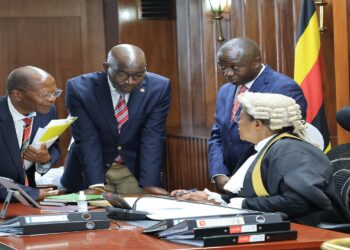In response to accusations of corruption against Mathias Mpuuga, a member of the Parliamentary Commission in the current legislature, Robert Kyagulanyi, the leader of his party, has demanded Mpuuga’s resignation. It is suggested that Mpuuga resign from his position since he is alleged to have transgressed a fundamental principle of the party.
But Mpuuga made it clear to the public on Saturday that the president of his party does not have the right to call for his resignation. He explained that although political parties are free to suggest people for the commission, they are not allowed to dismiss any member, regardless of the person they have nominated.
However, we must know that within the institutional system of governance, the removal of a Parliamentary commissioner from their post is a matter of great significance. It’s critical to comprehend the conditions and protocols around their possible dismissal to preserve transparency and accountability in legislative commissions.
This article explores the complexities of the removal of a Parliamentary commissioner from office, including the legislative and procedural framework that governs this important area of parliamentary oversight.
When a Parliamentary Commissioner is to removed from the commission under parliamentary rule of procedures; A member of commission other than Speaker or Leader of Government business or Leader of Opposition or Minister of Finance shall be removed from the office by Parliament for; Incompetence, insanity, misconduct and inability to perform the function of his/ her arising from the body or mind.
A motion for the resolution to remove the commissioner shall be initiated by submitting a written notice to the Clerk of Parliament. This notice must be signed by no fewer than one-third of all the voting members of Parliament, clearly indicating the intent to propose the motion for removal like how it was done on Mityana Municipality lawmaker Zaake Butebi.
The notice under Sub-rule (2) must specify the grounds for the motion, along with providing all relevant particulars supporting those grounds. After that, the procedures described in Sub-rules (2) to (7) will apply to the removal of the commissioner, with the necessary changes.
Subsequently, a motion for the resolution under this rule shall be placed on the order paper 14 days from the date on which the notice to remove the commissioner was communicated to the clerk. So the commissioner shall be removed upon the vote of at least half of all voting members of parliament.
Given the previously described procedural prerequisites, it is improbable that Kyagulanyi and his party will force Mpuuga to step down from his role in the Parliamentary Commission. This goal is significantly hampered by the strict requirements and procedures for filing a move for removal as well as the restrictions on the party’s power in these situations.
Do you have a story in your community or an opinion to share with us: Email us at editorial@watchdoguganda.com













